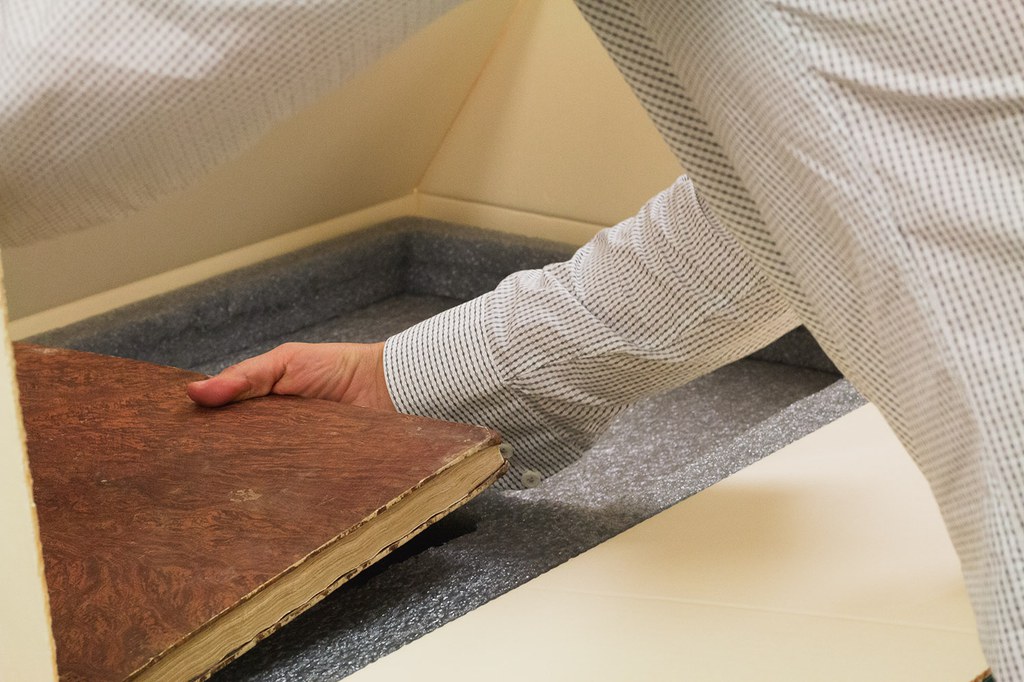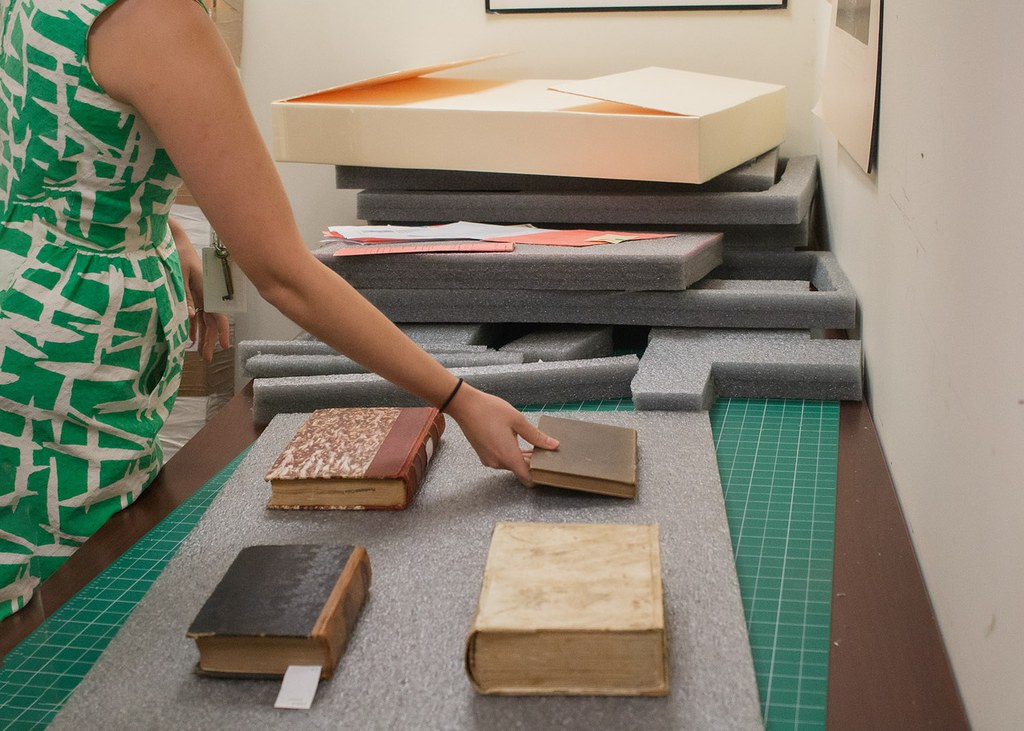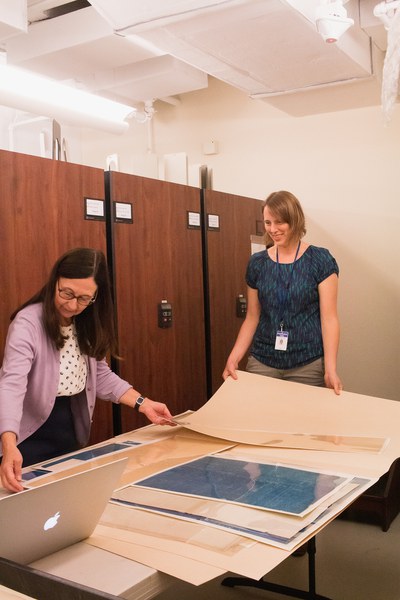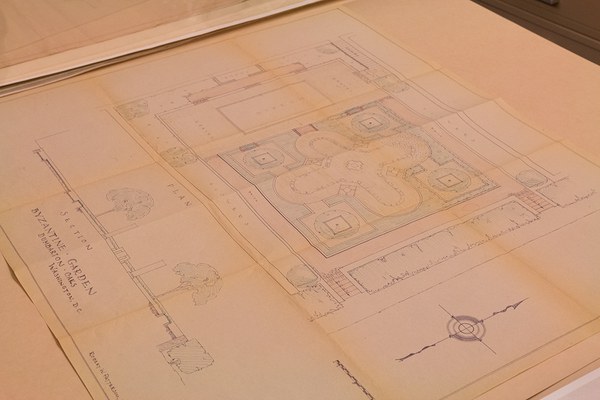By Julia Ostmann
Curious about what happens at Dumbarton Oaks when the museum closes and the garden gates lock? Recently relaunched series “Behind the Scenes” uncovers the hidden activities, surprising jobs, and remarkable discoveries that make a home of the humanities.
Next to eighteenth-century books brimming with serene views of villas, palaces, countryside scenes, and gardens along the Brenta River in Italy, curator of rare books Anatole Tchikine saws vigorously at a thick piece of foam.
“A half-centimeter more?” he asks rare book collection assistant Taylor Johnson. A set of other knives and cutting implements wait nearby.
Tchikine is building a custom foam bed for two volumes of Delle delicie del fiume Brenta, which number among the more than 300 objects (totaling nearly 6,000 pages) sent to Harvard Library Imaging Services this September for digitization. Created in the sixteenth through twenty-first centuries, the materials range from the tranquil Italian river engravings to a fragile archival volume to drawings of the Byzantine church Kariye Camii to a 7.5-foot-long garden design.

You might imagine digitizing rare materials is something like beaming a book to the internet—a slick, high-tech process for transposing an object to your computer screen. But in reality, digitization requires much physical labor and many hands. Before these rare books, slides, manuscripts, illustrations, and plans make it online, they must be selected, catalogued, conserved if necessary, prepared, packed, transported, and photographed.
Delle delicie del fiume Brenta safely stored in an art handler’s box, Tchikine begins packing up other volumes on the list, which include a book illustrating Suriname insects and flora by renowned botanical artist Maria Sibylla Merian and a description of exotic plants from the royal gardens at Kew.
“We have incredibly rich resources in our collection—books on garden design, architecture, horticulture, and botany, as well as Byzantine and Pre-Columbian materials,” says Tchikine. “Every shipment has to be a mixed batch to support our diverse fields of study.”

In the cupboard-sized storage room, Taylor Johnson and cataloger Kimball Clark help pack, move boxes and books, check catalogue records, and process paperwork. A recently acquired manuscript labeled “Illustrated file on a land dispute between a ranch owner and his Nahua neighbors,” featuring legal documents and several maps from colonial Mexico, demands extra care because of its fragility. At Harvard, the manuscript will undergo conservation before digitization.
“Manuscripts are a priority for digitization because they are by nature one of a kind,” says Taylor Johnson. Other selection criteria include usefulness for research, particularly when coupled with a lack of availability to scholars.
Meanwhile, in an adjoining room, piled high on a table are what look like office file folders—but each several feet long. Inside are original plans for the Dumbarton Oaks Garden created between 1922 and 1969 by pioneering landscape gardener Beatrix Farrand and associated architects. The more than 200 oversized drawings being digitized are part of the Garden Archives, and some depict elements (the tool house doors next to the Kitchen Gardens, for example) still seen in the garden today.
Other plans offer hints of a garden that never was. “This is a hand-colored copy of an unrealized floral lyre that was one of the designs considered for the Arbor Terrace,” says cataloger Wendy Johnson, who has worked with the Garden Archives for six years. “But it was never implemented.”

Wendy Johnson and Bettina Smith, manager of the Image Collection and Fieldwork Archives, are moving the mylar-protected drawings out of olive, tan, and grey filing cabinets lining the room and into acid-free cardstock folders. (The librarians also pack up architectural drawings and slides of Kariye Camii, an important Byzantine church in Istanbul, from the Byzantine Institute and Dumbarton Oaks Fieldwork Records and Papers.) Later in the week, professional art handlers from Crozier Fine Arts are coming to compile the folders into custom cardboard and plastic portfolios and drive them by truck to Harvard.
While these drawings were previously digitized along with the rest of the Garden Archives, some sketches hidden on the backs of certain sheets were never photographed, and the oversize nature of the documents resulted in low-resolution photographs. At Harvard, the large sheets of tracing paper, linen, blue pigmented paper, and other materials will be laid out on a long table. An overhead camera will take several different pictures to be stitched into a final high-resolution image that anyone can access from the Harvard Library website.
“Our goal is to create access, and digitization is the best tool we have to broaden that access as much as possible,” says Smith. “There’s a lot of mental and physical labor that goes into this process, but making these materials available to those who don’t have the means to come here in person is well worth it.”
Julia Ostmann is postgraduate writing and reporting fellow at Dumbarton Oaks. Photos by Elizabeth Muñoz Huber, postgraduate digital media fellow.

